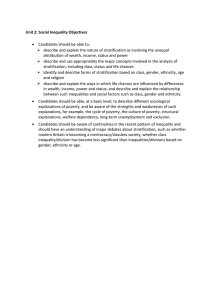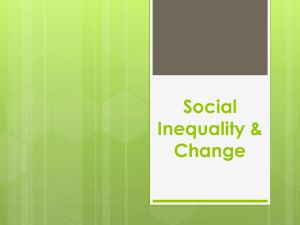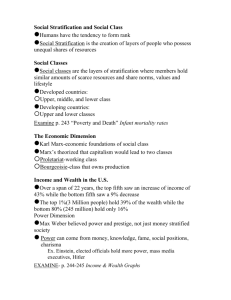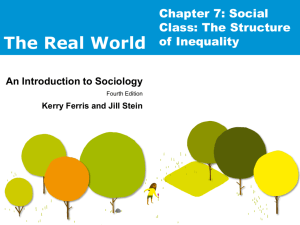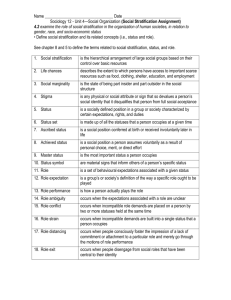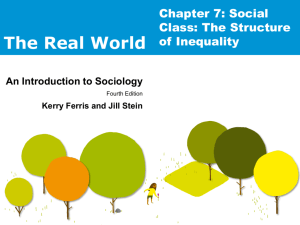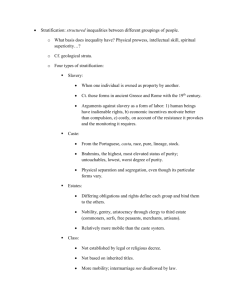Social Inequality & Change
advertisement
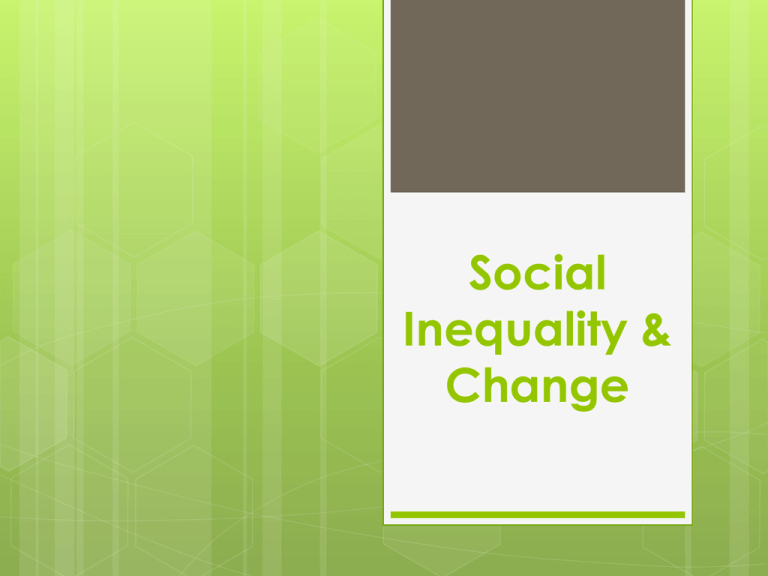
Social Inequality & Change Social Stratification STRATIFICATION Separation of society into: GROUPS…not individuals Societies are stratified based on: Categories Ranks Classes Socioeconomic status Gender Race Stratification results in inequality Resources, opportunities, and privileges distributed based on social hierarchy Open System Movement between classes (strata) is possible Three Horizontal Movement within a class No major change to wealth, power, or prestige Vertical types of social mobility Movement between classes Change in wealth, power, or prestige Intergenerational mobility Stratification Systems Closed System Assigned a status and remain throughout life Ascribed Caste system People inherit their position in society Stratification Systems cont’d CASTE SYSTEM Closed stratification system Position is inherited Stratified by: Race or ethnicity Religious status Economic status Involves: Endogamy Hereditary transmission of occupation Social identity India’s Caste System Caste Occupation Brahman Priests and scholars Kshatriya Nobles and warriors Vaishva Merchants and skilled artisans Shudra Common laborers Stratification Systems cont’d Class System Distribution of resources and rewards is based on achieved status Talent, effort, opportunity, exogamy Allows for social mobility Movement up or down the social ladder Can be difficult at times What Determines Social Class? Karl Marx Class is based on the ownership of the factors of production Class is based on three factors: Owners in a capitalist society Reap all profits Wealth (property) Bourgeoisie Max Weber Power Proletariat Sell labor for wages Emphasis on recognition of situation Ability to control behavior of others with or without their consent Prestige All assets Value of all things owned and income Respect, honor, recognition, or courtesy from others Based on views of others Can be based on many characteristics Does inequality help societies survive? Functionalists believe the stratification of society is inevitable because: Society must make certain that its positions are filled Some positions are more important than others Some positions require greater responsibility More important positions must be filled by the most qualified To motivate the more qualified people, society must offer them greater rewards Incentives: Higher salary, company car, stock options, country club membership, private jet, etc. Problems with Functional View: How do you measure the importance of one job versus another? The positions filled may not be merit based Some get ahead with hard work and ability; others inherit wealth Social stratification does not benefit everyone Some never have opportunities to advance their talents Is it then dysfunctional? Is conflict the basis of social stratification? In every society groups struggle for control of limited resources The group that gains control attempts to hold onto control Human nature is self-centered Use of social institutions to maintain control Conflict theorists argue that society is stratified by power How is social class determined? Reputational Community members rank each other Appropriate for use in small communities Subjective place themselves in the middle class Objective method Individuals determine their own social rank Many method method Includes 3 factors: income, occupation, education Least biased method Living in Poverty Poverty Standard of living below the minimum level considered adequate by society Poverty level – minimum income Persons in Poverty guideline family/household Income levels below this level are considered poor Effects of poverty: Life chances Opportunities to share in benefits of society $11,490 2 15,510 3 19,530 4 23,550 5 27,570 6 31,590 7 35,610 8 39,630 For families/households with more than 8 persons, add $4,020 for each additional person. Source: U.S. Department of Health & Human Services (2013) Life expectancy Inadequate nutrition and less access to medical care Largely impacts young children 1 MONOPOLY IN A STRATIFIED SOCIETY RESULTS: CLASS LEVEL UPPER $2,000 + MIDDLE $1,250 $1,999 WORKING $750 $1,249 LOWER < $749 INHERITANCE $2,500 $1,500 $1,000 $500 GROSS WORTH % ACHIEVING POSITIVE VERTICAL MOBILITY % EXPERIENCING NEGATIVE VERTICAL MOBILITY 50% (5 out of 10) 10% (1 out of 10) $1,815 31% (5 out of 16) 13% (2 out of 16) $1,315 36% (5 out of 14) 14% (2 out of 14) $633 20% (2 out of 10) 0% (0 out of 10) $3,172 >$3,000 = The Super Rich <250 = Extreme Poverty MONOPOLY IN A STRATIFIED SOCIETY RESULTS: CLASS LEVEL UPPER $2,000 + MIDDLE $1,250 $1,999 WORKING $750 $1,249 LOWER < $749 INHERITANCE $2,500 $1,500 $1,000 $500 GROSS WORTH % ACHIEVING POSITIVE VERTICAL MOBILITY % EXPERIENCING NEGATIVE VERTICAL MOBILITY $2,671 40% (4 out of 10) 10% (1 out of 10) $1,996 40% (6 out of 15) 0% (0 out of 15) $1,125 29% (4 out of 14) 0% (0 out of 14) $679 27% (3 out of 11) 0% (0 out of 11) >$3,000 = The Super Rich <250 = Extreme Poverty American Class System Middle Class (75% of population) Upper Class Makes up 1 - 5% of population 1% - $250,000 or more per year 5% - $150,000 or more per year “Old money” vs. “New Money” 15% of population Living below $23,050 (family of four) Working poor and the underclass Temporary or seasonal jobs Well-educated (postsecondary degrees) High-paying white collar positions $100,000 or more per year Lower middle class Lower Class Upper middle class College education Lower-level, white collar workers Between $32,500 and 60,000 per year Working class Blue-collar class Some education Hourly pay Salaries range between $23,050 to 32,500 per year Global Stratification Global Stratification Global Stratification Colonialism Nations 1st to industrialize took advantage Began with European nations Led to exploitation of labor and natural resources More recently Use of “economic imperialism” Global Stratification cont’d World Four Groups: Developed capitalism first Britain, France Resulted in a capitalist world economy – dominated by the most industrialized nations Semi-periphery System Theory Expansion of economic and political connections between nations – since the 1500s Core nations Grew dependent on trade with core nations Economies experienced less growth Mediterranean nations Periphery Limited to selling cash crops to core nations Eastern European nations External area Few economic connections with core nations (left out) Many African nations Global Stratification cont’d Dependency Least Industrialized Nations grew dependent on most industrialized Result of production transformation Brazil Theory – coffee plantations Least industrialized countries did not develop independent economies Culture of Poverty Least industrialized nations held back by their own culture Way of life perpetuates poverty Stick to traditional ways Experimentation too risky New farming or manufacturing techniques Characteristics of Collectives Limited Interaction Interaction is limited or non-existent Unclear Unclear or unconventional Limited norms unity Members unlikely to share sense of group unity Types of Collective Behavior Crowds Types: – temporary gathering Casual - concert and uncoordinated group action Object of attachment for a short period Panics Spontaneous Attachment to a style of appearance by a large group Fads – mob or riot Hostile emotions Activity or Idea Public opinion Y2K Fashion Emotionally charged Acting - speaker Common purpose Unfounded anxiety Little to no interaction Expressive Mass Hysteria – buying tickets Conventional Public views on issues Rumors Info. that is true/false that spreads rapidly Contagion Theory Crowd has hypnotic power People give up individuality Factors influencing behavior: Number of people Emotion Value-Added Theory Will collective behavior occur? Which direction will it take? Series of preconditions that lead to behavior Theories on Collective Behavior Emergent-Norm Theory Individuals in crowd have different attitudes, behaviors, and motivations Traditional apply norms do not Interaction New behaviors New norms Types of Social Movements Reactionary Members are suspicious and hostile towards change Example: KKK Conservative Members attempt to protect social values from change Example: Prohibitionists Revisionary Change or improve some part of society Usually focused on single issue Example: suffrage women’s Revolutionary Total and radical change Overthrow of a govt. Example: Indian independence Agitation Smaller of issue group stirs up public awareness Legitimation Movement gains more acceptance Attracts more attention Leaders begin to emerge Growth of the Bureaucratization Movement Social Movement becomes formal Develops ranked authority, policies, and strategy for success Institutionalization Movement becomes part of society Relative Deprivation Theory Explaining Social Group feels Movements economically or socially deprived Relative to others Attempt to gain access to: Higher incomes Better working conditions Voting rights Example: Women’s rights movement Resource Mobilization Theory Organization and effective use of resources Resources: Body of supporters Financial resources Access to media

